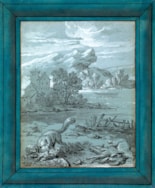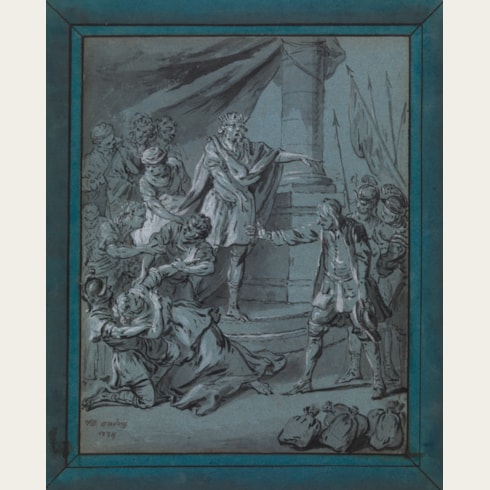Jean-Baptiste OUDRY
(Paris 1686 - Beauvais 1755)
The Fables of La Fontaine: The Wolf and the Fox
Signed and dated JB. Oudry 1733 at the lower left.
241 x 190 mm. (9 1/2 x 7 1/2 in.) [image]
308 x 260 mm. (12 1/8 x 10 1/4 in.) [with fictive mount]
Nearly all of the drawings are signed and dated, and, to judge from the dates, the artist seems to have made the drawings in order, in the sequence that they appear in La Fontaine's Fables. Oudry's most ambitious undertaking as a draughtsman, the project to illustrate the Fables seems not to have been a commission, but instead was done on the artist's own initiative, and his early biographer, the Abbé Louis Gougenot, notes that he worked on the drawings in the evenings.
It has been assumed that Oudry would have intended this series of drawings for the Fables to be engraved for publication, but this would have been a very expensive undertaking for the artist. Around 1751 Oudry sold the complete set of drawings to the amateur and collector Jean-Louis Regnard de Montenault, who decided to have them reproduced as prints and published as an illustrated book. Since Oudry's drawings were thought to be too free in execution to be used as models by the engravers, Montenault commissioned Charles-Nicolas Cochin the Younger to make copies of each of Oudry's drawings in a more linear style, and it was Cochin's drawings that were used by the large team of engravers who worked on the project. Montenault's celebrated edition of the Fables was published in four lavish volumes between 1755 and 1760, although Oudry himself did not live to see them.
The scene depicted is taken from Book XII, Fable IX of the Fables of La Fontaine:
'A fox once remarked to a wolf, "Dear friend, do you know that the utmost I can get for my meals is a tough old cock or perchance a lean hen or two. It is a diet of which I am thoroughly weary. You, on the other hand, feed much better than that, and with far less danger. My foraging takes me close up to houses; but you keep far away. I beg of you, comrade, to teach me your trade. Let me be the first of my race to furnish my pot with a plump sheep, and you will not find me ungrateful."
"Very well" replied the obliging wolf. "I have a brother recently dead, suppose you go and get his skin and wear it." This the fox accordingly did and the wolf commenced to give him lessons. "You must do this and act so, when you wish to separate the dogs from the flocks." At first Reynard was a little awkward, but he rapidly improved, and with a little practice he reached at last the perfection of wolfish strategy. Just as he had learned all that there was to know a flock approached. The sham wolf ran after it spreading terror all around, even as Patroclus wearing the armour of Achilles spread alarm throughout camp and city, when mothers, wives, and old men hastened to the temples for protection." In this case, the bleating army made sure there must be quite fifty wolves after them, and fled, dog and shepherd with them, to the neighbouring village, leaving only one sheep as a hostage.
This remaining sheep our thief instantly seized and was making off with it. But he had not gone more than a few steps when a cock crew near by. At this signal, which habit of life had led him to regard as a warning of dawn and danger, he dropped his disguising wolf-skin and, forgetting his sheep, his lesson, and his master, scampered off with a will.
Of what use is such shamming? It is an illusion to suppose that one is really changed by making the pretence. One resume's one's first nature upon the earliest occasion for hiding it.'
Oudry was a prodigious draughtsman, and drawings were an integral part of his artistic practice. Although the 18th century art historian Antoine-Joseph Dezallier d’Argenville wrote of him that ‘His finished drawings are all in black chalk, highlighted with white using the brush [and] his studies are also in black chalk, highlighted with white chalk’, and while it is certainly true that black and white chalks were his favoured medium as a draughtsman, Oudry worked also in pastel, red chalk, brown ink and sepia wash. While the Oudry scholar Hal Opperman catalogued around a thousand drawings by the artist, many of these were only known through descriptions in old auction catalogues. While Oudry parted with some drawings in his lifetime, the vast majority of his output as a draughtsman – mainly studies of animals and birds, highly finished landscapes and book illustrations, carefully organized into albums - remained in his studio until his death.
Provenance
Included in one of two albums containing all of Oudry's drawings for the Fables of La Fontaine, with the booksellers Frères de Bure, Paris, by 1828
Jean Jacques de Bure, Paris
His sale, Paris, 1-18 December 1853, lot 344 (sold for 1,800 francs to Thibaudeau)
Comte Adolphe-Narcisse Thibaudeau, Paris
Possibly given by him to the actress Mme. Eugenie Doche, and then sold by her for 2,500 francs to the bookseller Fontaine
Acquired from them for 5,000 francs by Solar Aaron Euryale, known as Félix Solar, in 1856
His sale, Paris, Charles Pillet, 19 November - 8 December 1860, lot 627 (sold for 6,100 francs to Cléder for Baron Taylor)
Baron Isidore Taylor, Paris
Émile Pereire, Paris
The booksellers Morgand et Fatout, Paris, probably in 1876
Acquired from them by Louis Roederer, Reims
By descent to his nephew, Léon Olry-Roederer, Reims and Paris
Sold through Agnew's, London, to Dr. A. S. W. Rosenbach, Philadelphia, in 1922
The Rosenbach Company, Philadelphia
Acquired from them by Raphael Esmerian, New York, in c.1946
His sale, Paris, Palais Galliera, 6 June 1973, part of lot 46 (sold for 2,000,000 francs)
Art Associates Partnership (Dr. Claus Virch), Bermuda, by whom one of the two albums disbound and the drawings contained therein - including the present sheet - thence sold separately
Adrian Ward-Jackson, London
Didier Aaron Inc., New York
Private collection.
Literature
Exhibition












